#cassini orbiter
Explore tagged Tumblr posts
Text
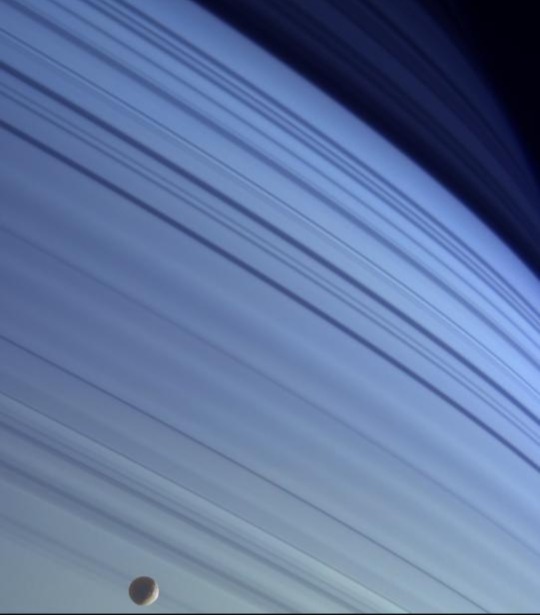
Saturn's little moon Mimas gliding against Saturn's blue, relatively cloudless atmosphere, and the rings' shadows. Image by the Cassini orbiter, 2005
Image Credit: NASA/JPL/Space Science Institute
#mimas#saturn#saturn rings#satty and the moonies#cassini spacecraft#cassini orbiter#cassini#astronomy#space#outer space#solar system#cosmos#nasa#esa#planets#space exploration#space images#space is cool
74 notes
·
View notes
Text

Saturn’s rings loop for hundreds of thousands of miles. And just beyond them, one of its largest moons changed everything we thought we knew about volcanic activity this far out in the solar system.

With a hard, frozen exterior, Enceladus’ surface averages minus-330 degrees Fahrenheit. It’s one of the coldest places in the Saturn system; an ice world, where we’d expect everything to be completely still, frozen and unchanging.

But in 2005, NASA’s Cassini spacecraft travelled to the south pole and discovered that stillness shattered. It captured explosive jets, constantly erupting from the surface. Giant plumes, far bigger than the moon they erupt from, are an incredible sight.

Over 660 pounds of water erupt from the surface of Enceladus every second, creating visible eruptions that can thrust up to 6,000 miles into space. It’s called “cryovolcanism,” “cryo” from the Greek for cold.

As Enceladus orbits Saturn, it wobbles like a raw egg, by about 0.12 degrees on its axis, a tiny but significant movement that tells us something about the moon’s interior. There is an outer shell of solid ice, around three miles thick, sitting on top of a global ocean of water.

When the liquid ocean is heated from below, by energy from tidal heating, it expands, so the liquid wants to take up more space. As it seeks to take up more space, it pushes up against the bottom of the ice shell. Once that water goes through a crack and then is exposed to the vacuum of space, it’s like a suction.

That’s how tidal heating, caused by an elliptical orbit, drives volcanic eruptions on Enceladus that aren’t even hot.
Solar System: Volcano Worlds on NOVA
#they found phosphates in the water too#so there might possibly be life at the vents#under the ice#would be incredible if true!!!!!!!#solar system#space#astronomy#long post#pbs nova
334 notes
·
View notes
Photo

2025 March 9
Cyclones at Jupiter's North Pole Image Credit: NASA, JPL-Caltech, SwRI, ASI, INAF, JIRAM
Explanation: Why are there so many cyclones around the north pole of Jupiter? The topic is still being researched. NASA's robotic Juno mission orbiting Jupiter took data in 2018 that was used to construct this stunning view of the curious cyclones at Jupiter's north pole. Measuring the thermal emission from Jovian cloud tops, the infrared observations are not restricted to the hemisphere illuminated by sunlight. They reveal eight cyclonic features that surround a cyclone about 4,000 kilometers in diameter, just offset from the giant planet's geographic north pole. Similar data show a cyclone at the Jovian south pole with five circumpolar cyclones. The south pole cyclones are slightly larger than their northern cousins. Oddly, data from the once Saturn-orbiting Cassini mission has shown that Saturn's north and south poles each have only a single cyclonic storm system.
∞ Source: apod.nasa.gov/apod/ap250309.html
153 notes
·
View notes
Text

Enceladus - taken by the Cassini orbiter on January 30 2017.
NASA/JPL-Caltech/SSI/Kevin M. Gill
1K notes
·
View notes
Text




The beautiful rings of Saturn in near infrared taken by the Cassini spacecraft in 2014. 🪐
📷: NASA / Maksim Kakitsev
—
Cassini–Huygens, commonly called Cassini, was a space-research mission by NASA, the European Space Agency (ESA), and the Italian Space Agency (ASI) to send a space probe to study the planet Saturn and its system, including its rings and natural satellites.
The Flagship-class robotic spacecraft comprised both NASA's Cassini space probe and ESA's Huygens lander, which landed on Saturn's largest moon, Titan.
Cassini was the fourth space probe to visit Saturn and the first to enter its orbit, where it stayed from 2004 to 2017.
The two craft took their names from the astronomers Giovanni Cassini (1625-1712) and Christiaan Huygens (1629-1695).
#Saturn#saturn rings#planet#space#universe#Cassini#Cassini spacecraft#spacecraft#Cassini–Huygens#NASA#ESA#ASI#space probe#astronomy
179 notes
·
View notes
Text
Astronomy Picture of the Day
2025 March 9

Cyclones at Jupiter's North Pole
The image shows the north pole of Jupiter in red (infrared) light. Many cyclonic swirls surround the pole.
Image Credit: NASA, JPL-Caltech, SwRI, ASI, INAF, JIRAM
Why are there so many cyclones around the north pole of Jupiter? The topic is still being researched. NASA's robotic Juno mission orbiting Jupiter took data in 2018 that was used to construct this stunning view of the curious cyclones at Jupiter's north pole. Measuring the thermal emission from Jovian cloud tops, the infrared observations are not restricted to the hemisphere illuminated by sunlight. They reveal eight cyclonic features that surround a cyclone about 4,000 kilometers in diameter, just offset from the giant planet's geographic north pole. Similar data show a cyclone at the Jovian south pole with five circumpolar cyclones. The south pole cyclones are slightly larger than their northern cousins. Oddly, data from the once Saturn-orbiting Cassini mission has shown that Saturn's north and south poles each have only a single cyclonic storm system.
Authors & editors: Robert Nemiroff (MTU) & Jerry Bonnell (UMCP)
NASA Official: Amber Straughn
A service of: ASD at NASA / GSFC,
NASA Science Activation
& Michigan Tech. U.
65 notes
·
View notes
Photo

Ice Moon Tethys from Saturn Orbiting Cassini
Credits: Cassini Imaging Team, SSI, JPL, ESA, NASA
70 notes
·
View notes
Photo

Fresh Tiger Stripes on Saturn's Enceladus, 2024-08-25
Do underground oceans vent through canyons on Saturn's moon Enceladus? Long features dubbed tiger stripes are known to be spewing ice from the moon's icy interior into space, creating a cloud of fine ice particles over the moon's South Pole and creating Saturn's mysterious E-ring. Evidence for this has come from the robot Cassini spacecraft that orbited Saturn from 2004 to 2017. Pictured here, a high resolution image of Enceladus is shown from a close flyby. The unusual surface features dubbed tiger stripes are visible in false-color blue. Why Enceladus is active remains a mystery, as the neighboring moon Mimas, approximately the same size, appears quite dead. An analysis of ejected ice grains has yielded evidence that complex organic molecules exist inside Enceladus. These large carbon-rich molecules bolster -- but do not prove -- that oceans under Enceladus' surface could contain life.
Credits: NASA's 'Astronomy Picture Of The Day.'
98 notes
·
View notes
Note
I don’t know if this is right to ask, but do you have any thoughts on the current state of spaceflight?
While I keep up with the current state of things, it's hard not to get political about more recent turn of events. But fuck it, everything is political these days.
I've been following the development of the Artemis program since Orion and SLS were a part of the cancelled Constellation Program. (SLS was called Aries V back then.) The major problem with them is every time a new president comes in, they always want to shake things up or think they know better than what is currently being done. With the exception of the Aries I rocket, they are always wrong and only delay landing humans on the moon. Which is why it has taken them this long to get to the point of constructing Artemis II. If NASA could be left alone for a while, they will get us there sooner rather than later.
It's frustrating seeing Elon and Trump mess them again or even saying they could get us to Mars in 4 years (which could never happen, even with all of the money in the world). At best, NASA is 20 years from landing humans on Mars but there isn't even a Mars mission in serious development right now. And switching NASA's focus from the Moon is going to ruin the momentum they have built up since 2010. We are finally getting close to leaving LEO and it will piss me off to no end if Musk tries to take over and cancel SLS. His starship booster is nowhere near human rated and I doubt heavy falcon has the delta-V to get Orion to the moon. Which leads me to believe if he does mess with it, it's only to funnel more money into his pockets. Just like his tunnel boring company and his attempt to sink California's high-speed rail project.
Messing with Artemis will take years to get back on track after they are kicked out, at which point, China will get there before we do. So to say I'm very pissed about it, is putting it lightly.
But for other programs, I've been happy to see them come online. The JWST has been blowing me away with the photos it's returned.
One program I'm excited for is the Uranus Orbiter. (If you laugh, get your head out of the gutter.) It's early in planning but after the Galileo and Cassini probes explored Jupiter and Saturn, it's high time the ice giants get their turn. It's unfortunate the Neptune probe wasn't also selected as well but there wasn't enough funding for both planets. Maybe at a later time they will send one, I hope I get to live long enough to see it.
(I've started and restarted writing this over the last week as I'm watching the news about NASA getting gutted by Elon Musk and his illegal doge group. I've given up and am just going to post it as it is now before anything changes.)
35 notes
·
View notes
Text

Mimas, a moon of Saturn. Cassini spacecraft, 2005
Image Credit: NASA/JPL/Space Science Institute
#mimas#saturn#satty and the moonies#cassini#cassini orbiter#cassini spacecraft#astronomy#space#outer space#solar system#cosmos#nasa#esa#death star#space is cool
34 notes
·
View notes
Text

Fresh Tiger Stripes on Saturn's Enceladus Image Credit: NASA, ESA, JPL, SSI, Cassini Imaging Team Explanation: Do underground oceans vent through canyons on Saturn's moon Enceladus? Long features dubbed tiger stripes are known to be spewing ice from the moon's icy interior into space, creating a cloud of fine ice particles over the moon's South Pole and creating Saturn's mysterious E-ring. Evidence for this has come from the robot Cassini spacecraft that orbited Saturn from 2004 to 2017. Pictured here, a high resolution image of Enceladus is shown from a close flyby. The unusual surface features dubbed tiger stripes are visible in false-color blue. Why Enceladus is active remains a mystery, as the neighboring moon Mimas, approximately the same size, appears quite dead. An analysis of ejected ice grains has yielded evidence that complex organic molecules exist inside Enceladus. These large carbon-rich molecules bolster -- but do not prove -- that oceans under Enceladus' surface could contain life.
Today's Astronomy Picture of the Day is my favorite celestial object, the reason I got into space and science at all! As a child the idea that the subsurface oceans of Enceladus could potentially host alien life spurred my imagination and desire to learn all about it.
#apod#astronomy picture of the day#enceladus#saturn#astronomy#cassini#nasa#esa#jpl#alien life#astrobiology
74 notes
·
View notes
Text
Whatever hit Mimas nearly destroyed it. What remains is one of the largest impact craters on one of Saturn's smallest round moons. Analysis indicates that a slightly larger impact would have destroyed Mimas entirely. The huge crater, named Herschel after the 1789 discoverer of Mimas, Sir William Herschel, spans about 130 kilometers and is featured here. Mimas' low mass produces a surface gravity just strong enough to create a spherical body but weak enough to allow such relatively large surface features. Mimas is made of mostly water ice with a smattering of rock - so it is accurately described as a big dirty snowball. The featured image was taken during the closest-ever flyby of the robot spacecraft Cassini past Mimas in 2010 while in orbit around Saturn.
Below are actual photos taken


This view, captured by Cassini Saturn on November 19, 2016, shows a closer side view of Mimas’ superlaser cann—er, I mean Herschel crater, with its 6 km high central peak.



#saturn planet#planet saturn#impact crater#crater#craters#moon craters#moon photography#moon#astrophotography#astronomy#nasa#astronomers#universe#nasa photos#outer space#astrophysics#nasawebb#hubble space telescope#saturns rings#space exploration#space#science#james webb space telescope#hubble telescope#space science#nasa science#science facts#planetary science#astronomy photography#i love astronomy
39 notes
·
View notes
Photo
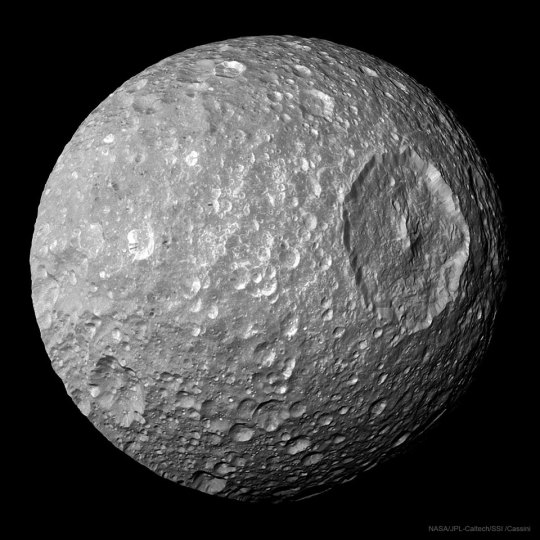
2025 January 12
Mimas: Small Moon with a Big Crater Image Credit: NASA, JPL-Caltech, Space Science Institute, Cassini
Explanation: Whatever hit Mimas nearly destroyed it. What remains is one of the largest impact craters on one of Saturn's smallest round moons. Analysis indicates that a slightly larger impact would have destroyed Mimas entirely. The huge crater, named Herschel after the 1789 discoverer of Mimas, Sir William Herschel, spans about 130 kilometers and is featured here. Mimas' low mass produces a surface gravity just strong enough to create a spherical body but weak enough to allow such relatively large surface features. Mimas is made of mostly water ice with a smattering of rock - so it is accurately described as a big dirty snowball. The featured image was taken during the closest-ever flyby of the robot spacecraft Cassini past Mimas in 2010 while in orbit around Saturn.
∞ Source: apod.nasa.gov/apod/ap250112.html
201 notes
·
View notes
Text
Launched between August and September 1977, Voyager 1 and Voyager 2 are the oldest and most distant probes built that are still active. They are also the only probes to have left our solar system and venture into the wider expanses of space. The secret to their long life? Nuclear power. But at some point, their mission will end.
The Voyagers began as planetary missions. Their goal was to carry out the so-called Planetary Grand Tour—that is, to visit the four outer planets of the solar system through a series of flyovers. Jupiter, Saturn, Uranus, and Neptune all got a new face thanks to the probes’ robotic cameras and their many scientific instruments.
The icy giants Uranus and Neptune, in particular, were studied for the first and only time in history by Voyager 2, while successful observations of Jupiter and Saturn were the basis for subsequent interplanetary missions to these worlds, such as Galileo, Juno, and Cassini-Huygens. Voyager 1, on the other hand, had Titan—Saturn’s largest moon and one of the most intriguing satellites in the outer solar system—as its primary target.
Once the Voyagers’ planetary journeys were over, it was possible to begin a new mission phase. After their last planetary stops, both probes reached escape velocity for the solar system, allowing them to be released from the sun’s gravity. Since 2012 for Voyager 1, and 2018 for Voyager 2, they have become interstellar. We know this because after those dates, sensors on the probes showed that charged particles from the sun became less numerous and energetic than those detected from the galactic environment. This was a golden opportunity to study the boundaries of the solar system and the environment outside of it.
The Secret to a Long Life
Reaching such a distance is only possible with the right energy source. Many probes use solar panels, but if they move too far from the sun, they become useless (the farthest probe that uses them is the Juno probe orbiting Jupiter). The secret of the Voyagers lies in their atomic hearts: both are equipped with three radioisotope thermoelectric generators, or RTGs—small power generators that can produce power directly on board. Each RTG contains 24 plutonium-238 oxide spheres with a total mass of 4.5 kilograms.
Plutonium-238 is an unstable isotope, which means it undergoes radioactive decay. The plutonium atoms in the RTGs release alpha particles—comprising two protons and two neutrons—and these hit the RTG canister, heating it up. The heat is then converted into electricity.
But as time passes, the plutonium on board is depleted, and so the RTGs produce less and less energy. The Voyagers are therefore slowly dying. Nuclear batteries have a maximum lifespan of 60 years.
In order to conserve the probes’ remaining energy, the mission team is gradually shutting down the various instruments on the probes that are still active. For example, in October, Voyager 2’s plasma science instrument—which measures electrically charged atoms passing the probe—was turned off; the same device on Voyager 1 was turned off in 2007 due to a malfunction. These instruments were used to study charged particles in the sun’s magnetic field, and it is precisely this detector in 2018 that determined that Voyager 2 had exited the heliosphere and become interstellar.
Four active instruments remain, including a magnetometer as well as other instruments used to study the galactic environment, with its cosmic rays and interstellar magnetic field. But these are in their last years. In the next decade—it’s hard to say exactly when—the batteries of both probes will be drained forever.
53 notes
·
View notes
Note
What's your favorite Spacecraft, both real and fictional?
It would be impossible to choose a favorite real spacecraft but my favorite fictional spacecraft is probably the Galaxy Class USS Enterprise NCC-1701-D.

Partly because I love the TNG technical manual and partly because it's just gorgeous. Easily the best looking ship to carry the name.
Some candidates for my favorite real spacecrafts: The Space Shuttle Orbiters (Space Transportation System) (1981-2011). Truly horrendous design. Unsafe, inefficient, but unquestionably gorgeous and utterly iconic, having defined human spaceflight for at least two generations.


You may have a death toll but I can't stay mad at you...
The Apollo Lunar Modules (1969-1972). These babies have a negative death toll, being instrumental in the rescue of the Apollo 13 astronauts and being uninvolved in the Apollo 1 fire. They are also one of two unquestionably iconic U.S. government vehicles designed and built by Grumman with "L" in the name--the other is the USPS Long Life Vehicle.

Skylab. They really did just say "what if we emptied out a rocket tank and turn it into a space station." and it has the dubious honor of being the only space station with a spacious enough volume to test cold-gas EVA-jetpacks and to have a shower. All while having its sun shield and one of its solar panels torn off. It's even large enough that you can run along the outside, and the centrifugal force of your own circular motion is enough to keep you on the walls/floor.
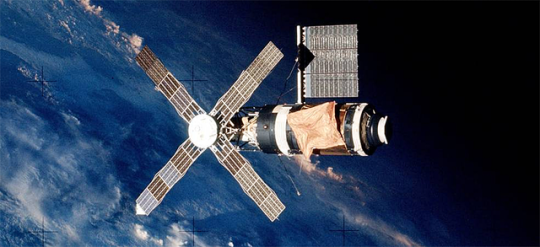


New Horizons (launch 2006, arrival at Pluto 2015, arrival at Arrokoth 2019).
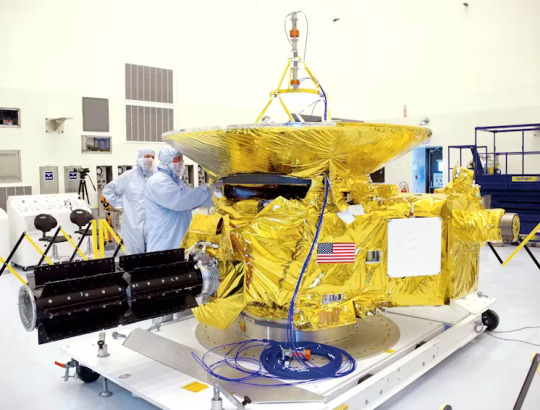


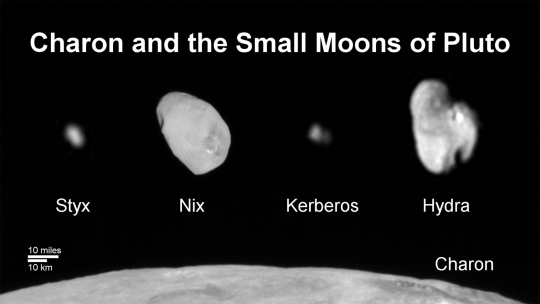
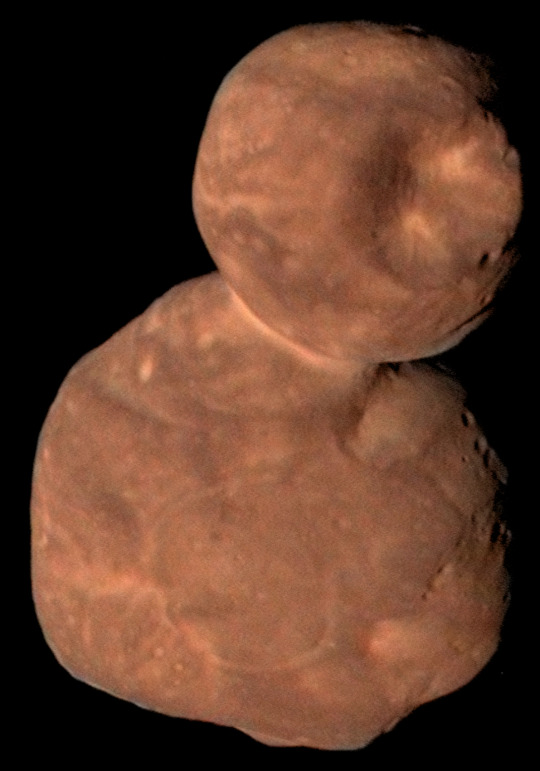
Cassini (launch 1997, arrival 2004, destroyed at end of mission 2017)





and the Voyagers (especially Voyager 2) Launch: 1977 Jupiter: 1979 Saturn: 1980 and 1981 Uranus: 1986 Neptune: 1989 Heliopause: 2012 & 2018 Current status: transmitting from Interstellar space (in terms of heliophysics. Still well within the sun's gravitational sphere of influence)

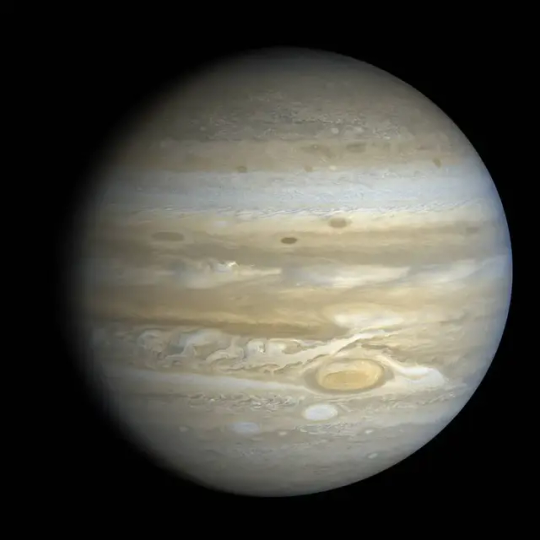



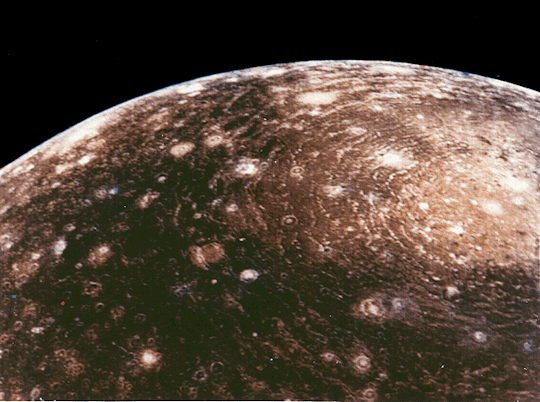

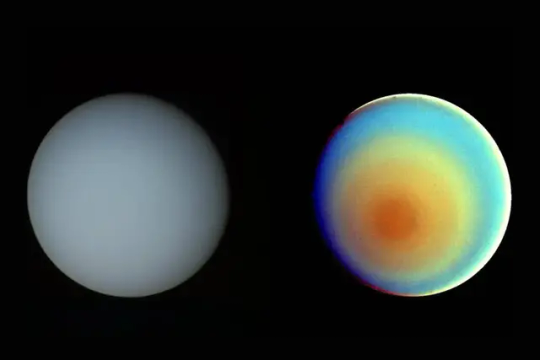

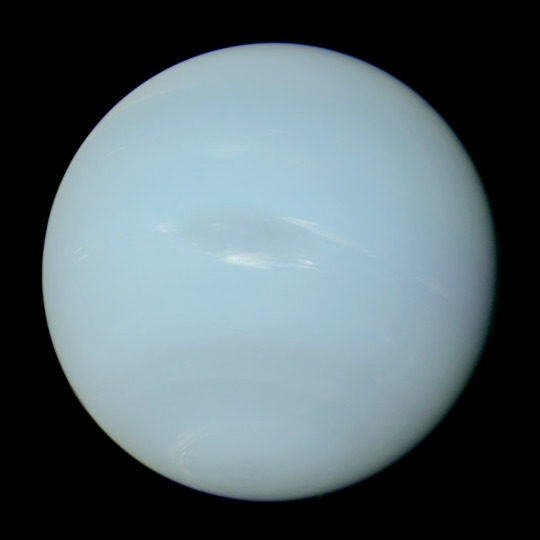

Robotic spacecrafts are the fuckin' best.
#space#space exploration#star trek#spacecraft#spaceship#Voyager spacecraft#Cassini spacecraft#New Horizons spacecraft#outer solar system#solar system#Jupiter#Io#Europa#Ganymede#Callisto#Saturn#Titan#Enceladus#Uranus#Miranda#Neptune#Triton#Pluto#Charon#Arrokoth#Space Shuttle#Apollo 11#Apollo Lunar Module#Lunar Module#Enterprise D
16 notes
·
View notes
Text
Astronomy Picture of the Day
2005 February 1

Saturn's Iapetus: Moon with a Strange Surface
Credit: Cassini Imaging Team, SSI, JPL, ESA, NASA
What has happened to Saturn's moon Iapetus? A strange ridge crosses the moon near the equator, visible near the bottom of the above image, making Iapetus appear similar to the pit of a peach. Half of Iapetus is so dark that it can nearly disappear when viewed from Earth. Recent observations show that the degree of darkness of the terrain is strangely uniform, like a dark coating was somehow recently applied to an ancient and highly cratered surface. The other half of Iapetus is relatively bright but oddly covered with long and thin streaks of dark. A 400-kilometer wide impact basin is visible near the image center, delineated by deep scarps that drop sharply to the crater floor. The above image was taken by the Saturn-orbiting Cassini spacecraft during a flyby of Iapetus at the end of last year.
Authors & editors: Robert Nemiroff (MTU) & Jerry Bonnell (USRA)
NASA Official: Jay Norris.
A service of: LHEA at NASA / GSFC
& Michigan Tech. U.
30 notes
·
View notes